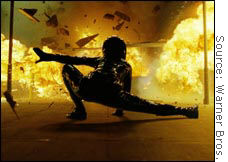NEW YORK (CNN/Money) -
The recently released "The Matrix: Reloaded" hits the big screen -- the very big screen -- this weekend in an important test for Imax, a little company looking to radically change its outlook by going Hollywood.
Imax, which makes screens up to eight stories high, and wide as the wingspan on a Boeing 737, is still found mainly in museums showing educational documentaries such as "Coral Reef Adventure."
 |
|
| The release of "The Matrix: Reloaded" on Imax screens this weekend is an important test for the small theater company. |
But the company, whose sales of $131 million last year were less than the reported $150 million it cost to make the Matrix sequel, has been expanding into the world of commercial theaters, trying to convert mainstream entertainment films into the large-screen format.
Last year a big version of "Star Wars Episode II: Attack of the Clones" hit Imax theaters in November, about six months after it first appeared in regular theaters and about the same time it became available on DVD.
This weekend, 39 of 95 commercial Imax theaters will start showing the Matrix sequel while the movie is still playing on thousands of conventional movie screens. In November, when the third leg of the trilogy, "The Matrix: Revolutions" hits the nation's multiplexes, it will open at the same time on Imax screens.
"Our goal was always to get more Hollywood content," said Imax co-CEO Rich Gelfond, who along with partner Bradley Wechsler bought a controlling interest in the 29-year-old company in 1994. "We began working on technology soon after we became involved. It wasn't until a year ago the technology was ready for prime time."
Today, out of 231 Imax theaters worldwide, only 95 are parts of commercial movie theaters. But that's expected to start changing soon. The company said 54 of the 59 orders for new Imax theaters are commercial theaters, and it has identified 250 other potential sites around the country where it hopes to sell a new theater.
Even with that growth, Imax will still be a niche product in a nation with about 34,000 movie screens. But it can be an important way for megaplexes to differentiate themselves from competitors.
| Related stories
|

|
|
|
|
Even a megaplex without room to add screens could benefit from converting two of its lesser-used screens to Imax screens for less than $3 million, said Eric Wold, analyst with Merriman Curham Ford & Co., a San Francisco investment banking firm.
"If the movie is a big success this weekend, I think you'll see a pretty big ramp in signings that theater owners want to get it in place before competitors do," said Wold. "Right now, the studios want this to succeed as much as anyone else. They want to be able to have a premium product with premium pricing."
Wold has set a $10 target price for Imax stock, but said the shares are likely to be volatile for some time, like the animated film studio Pixar, with spikes tied to the release of films, until the company ends up with more product in the pipeline.
Imax (IMAX: Research, Estimates) has risen nicely in recent months, bringing it back near its 52-week high; the stock managed small gains Friday.
Because this weekend's release comes weeks after the marketing rush for the movie's original release, the promotional effort is somewhat muted. There is no national media campaign. That's one of the reason November's simultaneous release will be considered an even more important test.
So far, no other major films are set to have an Imax version, although Gelfond said negotiations are under way with a number of studios. He said the company needs to have four-to-six blockbuster Hollywood movies a year in the format, each playing for six-to-10 weeks, for the theaters to have the content they want to justify new screens.
Click here for a look at media and entertainment stocks
Converting films from traditional 35-millimeter prints to Imax format is still expensive, about $2 million-to-$3 million a movie, with each print costing another $25,000 compared with the $1,500 cost of a standard film print. But the company believes it can create a premium product, allowing theaters to charge $4 or $5 more a ticket for devoted film fans wanting the enhanced experience.
New York art student Alicia Philley is already excited about the chance to see the Imax version of "The Matrix: Reloaded" even though she saw the film on its opening weekend three weeks ago.
"I knew when it opened I'd see it more than once," she said. "It was just a bonus that it could be Imax. There's something cool about the Imax screen; you just feel in it a little more. It envelops you."

|

